by Calculated Risk on 10/18/2023 12:00:00 PM
Wednesday, October 18, 2023
AIA: Architecture Billings "New Decline in Business Condition"; Multi-family Billings Decline for 14th Consecutive Month
Note: This index is a leading indicator primarily for new Commercial Real Estate (CRE) investment.
From the AIA: AIA/Deltek Architecture Billings Index Reports New Decline in Business Condition
Business conditions at architecture firms declined again in September, the AIA/Deltek Architecture Billings Index (ABI) reports. The score of 44.8 for September is the lowest score reported since December 2020 during the height of the pandemic. Any score below 50.0 indicates decreasing business conditions and this score indicates a significant increase in firms reporting declining billings.
“The September ABI score reflects a marked downturn in business conditions at architecture firms, with the sharpest decline observed since the peak of the pandemic," said Kermit Baker, PhD, AIA Chief Economist. "While more firms are reporting a decrease in billings, the report also shows the hesitance among clients to commit to new projects with a slump in newly signed design contracts. As a result, backlogs at architecture firms fell to 6.5 months on average in the third quarter, their lowest level since the fourth quarter of 2021."
It's clear that all regions of the country are feeling this impact, with firms in the West continuing to face particularly challenging conditions Only one sector, firms with an institutional specialization, remained flat while all other sectors reported declining billings. Firms with a multifamily residential specialization saw more decline, a continuation of month over month declines since August 2022.
...
• Regional averages: Northeast (46.4); South (46.2); Midwest (49.3); West (44.3)
• ector index breakdown: commercial/industrial (45.0); institutional (50.1); mixed practice (firms that do not have at least half of their billings in any one other category) (46.2); multifamily residential (43.5)
emphasis added
 Click on graph for larger image.
Click on graph for larger image.This graph shows the Architecture Billings Index since 1996. The index was at 44.8 in September, down from 48.1 in August. Anything below 50 indicates a decrease in demand for architects' services.
Note: This includes commercial and industrial facilities like hotels and office buildings, multi-family residential, as well as schools, hospitals and other institutions.
This index usually leads CRE investment by 9 to 12 months, so this index suggests a slowdown in CRE investment into 2024.
September Housing Starts: Near Record Number of Multi-Family Housing Units Under Construction
by Calculated Risk on 10/18/2023 09:14:00 AM
Today, in the CalculatedRisk Real Estate Newsletter: September Housing Starts: Near Record Number of Multi-Family Housing Units Under Construction
Excerpt:
The third graph shows the month-to-month comparison for total starts between 2022 (blue) and 2023 (red).There is much more in the post. You can subscribe at https://calculatedrisk.substack.com/
Total starts were down 7.2% in September compared to September 2022. And starts year-to-date are down 12.1% compared to last year.
Starts have been down year-over-year for 15 of the last 17 months (May and July 2023 were the exceptions), and total starts will be down this year - although the year-over-year comparisons will be somewhat easier in Q4.
Housing Starts Increased to 1.358 million Annual Rate in September
by Calculated Risk on 10/18/2023 08:30:00 AM
From the Census Bureau: Permits, Starts and Completions
Housing Starts:
Privately‐owned housing starts in September were at a seasonally adjusted annual rate of 1,358,000. This is 7.0 percent above the revised August estimate of 1,269,000, but is 7.2 percent below the September 2022 rate of 1,463,000. Single‐family housing starts in September were at a rate of 963,000; this is 3.2 percent above the revised August figure of 933,000. The September rate for units in buildings with five units or more was 383,000.
Building Permits:
Privately‐owned housing units authorized by building permits in September were at a seasonally adjusted annual rate of 1,473,000. This is 4.4 percent below the revised August rate of 1,541,000 and is 7.2 percent below the September 2022 rate of 1,588,000. Single‐family authorizations in September were at a rate of 965,000; this is 1.8 percent above the revised August figure of 948,000. Authorizations of units in buildings with five units or more were at a rate of 459,000 in September.
emphasis added
 Click on graph for larger image.
Click on graph for larger image.The first graph shows single and multi-family housing starts since 2000.
Multi-family starts (blue, 2+ units) increased in September compared to August. Multi-family starts were down 31.4% year-over-year in September.
Single-family starts (red) increased in September and were up 8.6% year-over-year.
 The second graph shows single and multi-family housing starts since 1968.
The second graph shows single and multi-family housing starts since 1968. This shows the huge collapse following the housing bubble, and then the eventual recovery - and the recent collapse in single-family starts.
Total housing starts in September were below expectations and starts in July and August were revised down slightly, combined.
I'll have more later …
MBA: Mortgage Applications Decreased in Weekly Survey
by Calculated Risk on 10/18/2023 07:00:00 AM
From the MBA: Mortgage Applications Decrease in Latest MBA Weekly Survey
Mortgage applications decreased 6.9 percent from one week earlier, according to data from the Mortgage Bankers Association’s (MBA) Weekly Mortgage Applications Survey for the week ending October 13, 2023.
The Market Composite Index, a measure of mortgage loan application volume, decreased 6.9 percent on a seasonally adjusted basis from one week earlier. On an unadjusted basis, the Index decreased 7 percent compared with the previous week. The Refinance Index decreased 10 percent from the previous week and was 12 percent lower than the same week one year ago. The seasonally adjusted Purchase Index decreased 6 percent from one week earlier. The unadjusted Purchase Index decreased 5 percent compared with the previous week and was 21 percent lower than the same week one year ago.
“Applications decreased to their lowest level since 1995, as the 30-year fixed mortgage rate increased for the sixth consecutive week to 7.70 percent – the highest level since November 2000,” said Joel Kan, MBA’s Vice President and Deputy Chief Economist. “Both purchase and refinance applications declined, driven by larger drops for conventional applications. Purchase applications were 21 percent lower than the same week last year, as homebuying activity continues to pull back given reduced purchasing power from higher rates and the ongoing lack of available inventory. The ARM share was 9.3 percent, the highest share in 11 months, as some borrowers look for alternative ways to lower their monthly payments. Refinance activity was at its lowest level since early 2023. There is very limited refinance incentive with mortgage rates at multi-decade highs.”
...
The average contract interest rate for 30-year fixed-rate mortgages with conforming loan balances ($726,200 or less) increased to 7.70 percent from 7.67 percent, with points decreasing to 0.71 from 0.75 (including the origination fee) for 80 percent loan-to-value ratio (LTV) loans.
emphasis added
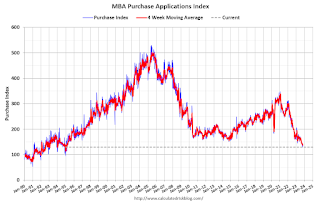 Click on graph for larger image.
Click on graph for larger image.The first graph shows the MBA mortgage purchase index.
According to the MBA, purchase activity is down 21% year-over-year unadjusted.
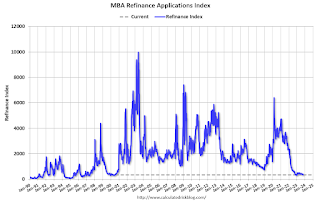
Tuesday, October 17, 2023
Wednesday: Housing Starts, Beige Book
by Calculated Risk on 10/17/2023 07:51:00 PM
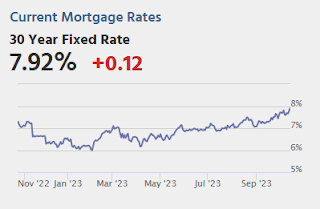
Wednesday:
• At 7:00 AM ET, The Mortgage Bankers Association (MBA) will release the results for the mortgage purchase applications index.
• At 8:30 AM, Housing Starts for September. The consensus is for 1.405 million SAAR, up from 1.283 million SAAR.
• During the day, The AIA/Deltek's Architecture Billings Index for September (a leading indicator for commercial real estate).
• At 2:00 PM, the Federal Reserve Beige Book, an informal review by the Federal Reserve Banks of current economic conditions in their Districts.
Lawler: Early Read on Existing Home Sales in September
by Calculated Risk on 10/17/2023 01:55:00 PM
Today, in the Calculated Risk Real Estate Newsletter: Lawler: Early Read on Existing Home Sales in September
A brief excerpt:
From housing economist Tom Lawler:There is much more in the article. You can subscribe at https://calculatedrisk.substack.com/
Based on publicly-available local realtor/MLS reports released across the country through today, I project that existing home sales as estimated by the National Association of Realtors ran at a seasonally adjusted annual rate of 4.00 million in September, down 1.0% from August’s preliminary pace and down 14.5% from last September’s seasonally adjusted pace. Unadjusted sales should show a larger YOY decline, reflecting this September’s lower business day count relative to last September’s.
Local realtor/MLS reports suggest that the median existing single-family home sales price last month was up by about 3.4% from last September.
CR Note: The National Association of Realtors (NAR) is scheduled to release September existing home sales on Thursday, October 19th, at 10:00 AM ET. The consensus is for 3.94 million SAAR, down from 4.04 million in August.
NAHB: Builder Confidence Decreased in October
by Calculated Risk on 10/17/2023 10:00:00 AM
The National Association of Home Builders (NAHB) reported the housing market index (HMI) was at 40, down from 44 last month. Any number below 50 indicates that more builders view sales conditions as poor than good.
From the NAHB: Mortgage Rates Well Above 7% Continue to Hammer Builder Confidence
Stubbornly high mortgage rates that have climbed to a 23-year high and have remained above 7% for the past two months continue to take a heavy toll on builder confidence, as sentiment levels have dropped to the lowest point since January 2023.
Builder confidence in the market for newly built single-family homes in October fell four points to 40 from a downwardly revised September reading, according to the National Association of Home Builders (NAHB)/Wells Fargo Housing Market Index (HMI) released today. This is the third consecutive monthly drop in builder confidence.
“Builders have reported lower levels of buyer traffic, as some buyers, particularly younger ones, are priced out of the market because of higher interest rates,” said NAHB Chairman Alicia Huey, a custom home builder and developer from Birmingham, Ala. “Higher rates are also increasing the cost and availability of builder development and construction loans, which harms supply and contributes to lower housing affordability.”
Since late September, mortgage rates are up nearly 40 basis points to 7.57%, according to Freddie Mac. Interest rates have increased on the Federal Reserve’s apparent higher-for-longer monetary policy stance, better than expected macro growth during the third quarter and longer-term concerns over government budget deficits.
“The housing affordability crisis can only be solved by adding additional attainable, affordable supply,” said NAHB Chief Economist Robert Dietz. “Boosting housing production would help reduce the shelter inflation component that was responsible for more than half of the overall Consumer Price Index increase in September and aid the Fed’s mission to bring inflation back down to 2%. However, uncertainty regarding monetary policy is contributing to affordability challenges in the market.”
As a result of the extended high interest environment, many builders continue to reduce home prices to boost sales. In October, 32% of builders reported cutting home prices, unchanged from the previous month but still the highest rate since December 2022 (35%). The average price discount remains at 6%. Meanwhile, 62% of builders provided sales incentives of all forms in October, up from 59% in September and tied with the previous high for this cycle set in December 2022.
...
All three major HMI indices posted declines in October. The HMI index gauging current sales conditions fell four points to 46, the component charting sales expectations in the next six months dropped five points to 44 and the gauge measuring traffic of prospective buyers dipped four points to 26.
Looking at the three-month moving averages for regional HMI scores, the Northeast fell four points to 50, the Midwest dropped three points to 39, the South fell five points to 49 and the West posted a six-point decline to 41.
emphasis added
 Click on graph for larger image.
Click on graph for larger image.This graph shows the NAHB index since Jan 1985.
This was well below the consensus forecast.
Industrial Production Increased 0.3% in September
by Calculated Risk on 10/17/2023 09:15:00 AM
From the Fed: Industrial Production and Capacity Utilization
Industrial production increased 0.3 percent in September and advanced at an annual rate of 2.5 percent in the third quarter. Manufacturing output rose 0.4 percent in September, the index for mining moved up 0.4 percent, and the index for utilities decreased 0.3 percent. At 103.6 percent of its 2017 average, total industrial production in September was 0.1 percent above its year-earlier level. Capacity utilization moved up 0.2 percentage point to 79.7 percent in September, a rate that is equal to its long-run (1972–2022) average.
emphasis added
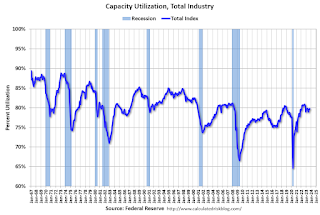 Click on graph for larger image.
Click on graph for larger image.This graph shows Capacity Utilization. This series is up from the record low set in April 2020, and above the level in February 2020 (pre-pandemic).
Capacity utilization at 79.7% is at the average from 1972 to 2022. This was above consensus expectations.
Note: y-axis doesn't start at zero to better show the change.
 The second graph shows industrial production since 1967.
The second graph shows industrial production since 1967.Industrial production increased in August to 103.6. This is above the pre-pandemic level.
Industrial production was above consensus expectations, however the previous month was revised down.
Retail Sales Increased 0.7% in September
by Calculated Risk on 10/17/2023 08:30:00 AM
On a monthly basis, retail sales were up 0.7% from August to September (seasonally adjusted), and sales were up 3.8 percent from September 2022.
From the Census Bureau report:
Advance estimates of U.S. retail and food services sales for September 2023, adjusted for seasonal variation and holiday and trading-day differences, but not for price changes, were $704.9 billion, up 0.7 percent from the previous month, and up 3.8 percent above September 2022. ... The July 2023 to August 2023 percent change was revised from up 0.6 percent to up 0.8 percent (±0.1 percent).
emphasis added
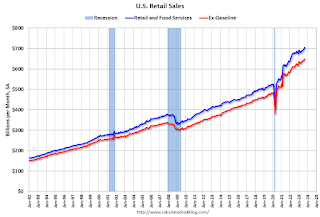 Click on graph for larger image.
Click on graph for larger image.This graph shows retail sales since 1992. This is monthly retail sales and food service, seasonally adjusted (total and ex-gasoline).
Retail sales ex-gasoline were up 0.7% in September.
The second graph shows the year-over-year change in retail sales and food service (ex-gasoline) since 1993.
Retail and Food service sales, ex-gasoline, increased by 4.3% on a YoY basis.
 The increase in sales in September was well above expectations, and sales in July and August were revised up.
The increase in sales in September was well above expectations, and sales in July and August were revised up.
Monday, October 16, 2023
Tuesday: Retail Sales, Industrial Production, Homebuilder Survey
by Calculated Risk on 10/16/2023 07:10:00 PM

Last week was mostly good for mortgage rates, even if the goodness was made possible in large part by the badness of the previous week. By Friday, rates were 0.15% lower than the previous Friday, on average.Tuesday:
As the new week begins, virtually all of that progress has been erased. In other words, the average lender is now very close to the same rates seen on Friday, October 6th. [30 year fixed 7.80%]
emphasis added
• At 8:30 AM ET, Retail sales for September will be released. The consensus is for a 0.2% increase in retail sales.
• At 9:15 AM, The Fed will release Industrial Production and Capacity Utilization for September. The consensus is for a 0.1% increase in Industrial Production, and for Capacity Utilization to decrease to 79.6%.
• At 10:00 AM, The October NAHB homebuilder survey. The consensus is for a reading of 44, down from 45 in September. Any number below 50 indicates that more builders view sales conditions as poor than good.


